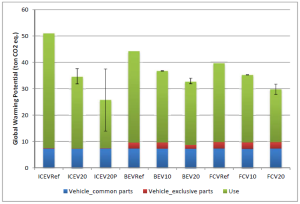Sustainable Mobility
Natural gas has long been considered a cleaner fuel than coal and petroleum. With the advent of new natural gas extraction technologies, such as horizontal drilling and hydraulic fracturing, and more stringent future Corporate Average Fuel Economy (CAFE) and vehicle emission standards, a dramatic increase in the use of natural gas and its chemical derivatives for mobility needs has been predicted for the next few decades. Therefore, the environmental impacts associated with the delivery of driven vehicle miles are worth investigating for the alternative modes of natural gas utilization in the transportation sector.
Although alternative fuel vehicles and their environmental performances have become the focus of life cycle practitioners in recent years, little research has been done to compare the life cycle impacts of delivering mobility using the same fuel resource for different personal passenger vehicles, especially when this resource is natural gas. In our laboratory, the environmental impacts of delivering driven vehicle miles are evaluated using life cycle assessment (LCA) for different vehicle fleets, each powered either directly or indirectly by natural gas. Fleets studied include: battery electric vehicles (BEVs) using electricity generated from natural gas combined cycle (NGCC) power plants; Compressed natural gas vehicles (CNGVs), which are internal combustion vehicles modified to burn compressed natural gas; and fuel cell vehicles (FCVs) powered by hydrogen produced from steam methane reforming of natural gas.

